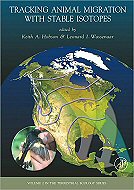|
Tracking Animal Migration with Stable Isotopes
|
|
Edited by: Keith A. Hobson, Leonard I Wassenaar
|

|

Long-distance movement and migration of terrestrial animals represents one of the most spectacular, yet poorly understood, features of their life cycles. Migration can be both dramatic and bretahtaking, often involving movement over thousands of kilometers. Apart from understanding the evolution of this phenomenon and the myriad of adaptations migratory organisms use, effective conservation of migrant organisms requires the ability to quantify and link the diverse geographic regions used throughout their annual cycle. For decades, approaches to making such linkage have relied on limited observational networks or on traditional methods, such as tagging and recovery of the same individual. Unfortunately, with the exception of a few large species, observation and tagging have not yielded scientifically meaningful results […]
[…] Over the past decade, intrinsic chemical markers have become key in the study of migration. Stable isotopes are a successful example of intrinsic markers that have yielded new and valuable insights into animal migration. This goal of this book is to provide a consolidated overview of the current knowledge of stable isotopes in terrestrial migration research questions. […]
Key Features
• Introduction to the study of terrestrial animal migration and the advantages of stable isotope as intrinsic geospatial tracers
• Application of isotopic methods to tracking migration
• Practical guidelines and discussions of sample collection, sample
preparation, isotope-ratio mass spectrometry data analysis, and
issues of isotopic exchange and heterogeneity
• Examples of isoscapes and their applicability to migration ecology.
• Enhanced understanding of data and statistical analysis in isotope-based studies of migratory animals
• In-depth discussion of areas where future research is needed
Keith A. Hobson holds a Ph.D. from the University of Saskatchewan, Canada (1992) […]. He is a senior research scientist with Environment Canada and adjunct professor in Biology at the University of Saskatchewan.
Leonard I Wassenaar holds a Ph.D. in isotope geochemistry form the University of Waterloo, Canada (1991) […]. He is currently a senior research scientist with environment Canada, and he holds adjunct professorships at the University of Waterloo and the University of Saskatchewan.
|
|
